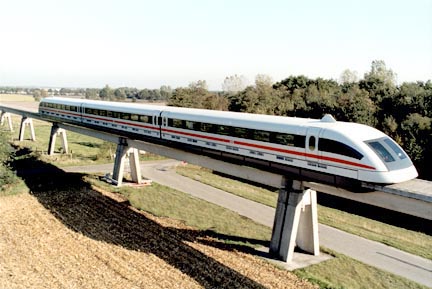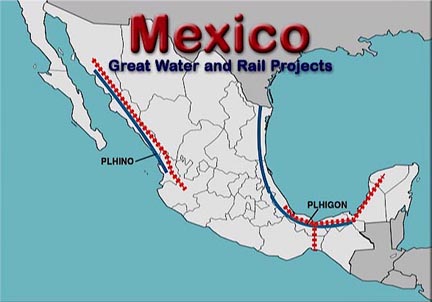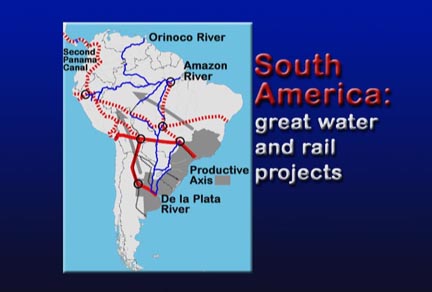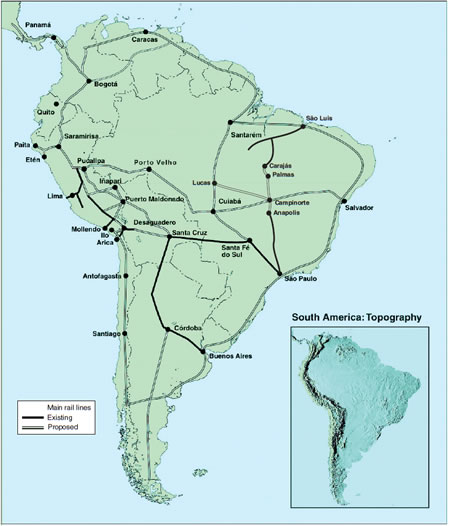MAPS of Great
Infrastructure Development Projects
Around the World
INFRASTRUCTURE DEVELOPMENT CORRIDOR
Magnetically Levitated Trains
|
Africa Water and Railroad Development Projects Oasis Plan for the Middle East |
North American Water and Power Alliance Plan (NAWAPA) Proposed Interamerican Railroad Line |
INFRASTRUCTURE DEVELOPMENT CORRIDOR
LaRouche's idea of the "infrastructure corridor," is currently under discussion, to be implemented, in many nations around the world. It is reminiscent of the idea associated with Abraham Lincoln's concept of the Transcontinental Railway of the mid 19th century. Cities, as industrial, cultural, and educational centers were developed all along the route, as the American continent was developed from the Atlantic to the Pacific. The proper design of the development of any very large land-area must be based on certain geographical principles. In modern history of the past two centuries, the center of these geographical principles is transportation routes, chiefly for water-borne commerce and trunk railways, still the cheapest and most efficient modes for movement of produced goods.

Think of these routes as not merely conveyer-belts of people, goods, water, and power, but as like production-lines: a zone of efficient, high-density production of agricultural, mining, and manufactured goods, running the length of the trunk-line and with a width of up to approximately a hundred kilometers.
Just as Mr. LaRouche and his associates have detailed this within their prescriptions of design for both the Productive Triangle and the Eurasia Land-Bridge, and as the 1861-1876 Lincoln reforms defined the development of the U.S. transcontinental railway system, we begin with the natural routes for trunk-lines of trade. These lines often turn out to have a history going back to medieval, or even more ancient times, as the Silk Roads did. Do not think of this as merely passage-ways for transportation; think of them as development corridors, just as the U.S.A.'s Lincoln reform of 1861-1876 defined the relationship between transcontinental railways, and economic development of the land-areas through which the railways passed. Think of these as strategic development routes.
Today, such a strategic development route features a modern high-speed, high-capacity railway spine: the cheapest method of rapid transport of manufactured goods, and the fastest economical route for movement of perishable refrigerated and other agricultural goods. Attached to the lengths of that spine, are subordinated railway and automobile routes, and also trunk-lines for large-volume water and power development and transmission.
The above represents an elaboration and development of that idea: a continuous strip of land, approximately 100 kilometers wide, centered on a major inland transport route (such as a railroad line, or magnetically levitated train route), with parallel lines of high-capacity electric lines, fuel pipelines, fiber optic cables, water supply lines (perhaps including irrigation), and so on, establishing the precondition for ratios of power, water, and other inputs for every kind of industrial, agriculture, mining, and urban activity--the most important one being ingenuity.
Magnetically-levitated Trains

If you want to have an industry, you have to move materials to it and from it. Therefore, you require an efficient transportation system which has a low physical cost of transportation per ton of weight. The most efficient, of course, is rail--rail or magnetic levitation--the lowest in the cost, physical cost per ton mile. Roads are very inefficient, and the only time you use roads, is when it is inefficient to build rail. And you try to use them only for very short distances, because they're very costly, per ton mile, relative to rail. Rail is much cheaper. Water is the cheapest, but that's not land. But, water is slow.
To deliver those technologies, we shall not generally do it by sea. If we build development corridors, corridors of approximately 100 km width across Eurasia, especially Central Asia, then we will create a situation, which, with the use of magnetic-levitation transport, we will transport freight from Rotterdam to Tokyo, at speeds of up to 300 km per hour. The result will be that, since we are doing it across land, and since every few kilometers of land area is developing new wealth, the net cost of shipping a ton of goods from Rotterdam to Tokyo will be less than zero. And it will go at speeds of up to 300 km per hour. Why? Because, when you transport across a development corridor, the use of that development corridor increases the production of wealth along the way. Therefore, you are actually generating wealth by transporting it.
Magnetic levitation systems of mass transport are not merely an upgrading from friction-rail systems. Although the speeds achievable do relieve the presently excessive reliance on passenger air transport for medium-distance travel, the revolutionary impact of magnetic levitation shows itself in the transport and classification of freight shipments. Of course, on the horizon, there is the prospect of magnetic-levitation transport within long evacuated tunnels, and well above ordinary supersonic speeds. We would rely on the latter for sub-surface transport among centers in a science-city form of astrophysical research and development, and production colonies on the Moon or Mars, for example.
Proposed Interamerican Railroad Line
click here for article about this proposed rail line

Water and Rail projects for Mexico

"LaRouche speaks to INCOPSE," August 2, 2001
South and Central America Projects:
Powerhouse for Development
South America: Transcontinental Railroad
EIRNS |
Everyone Wants In on a Bioceanic Corridor in South America (April 2015)

Build the Great Projects of South America
The map shows the great water projects called for in South America, and also illustrates the continental scale required for all basic infrastructure improvements: transcontinental highways, rail routes, new cuts through the Isthmus of Panama and Colombia for expanded Pacific-Atlantic transit (1 and 2 on the map), coastal development, and modernization of urban and farm regions.
The map locates and names 12 specific canals and lakes, and denotes a gray "Productive Axis" zone along the Brazil/Uruguay/Argentina region that would move inland (as the arrows show) with the development of the upland water projects.

The dark black lines show the principal potentially navigable channels of the great river basins, that can be hooked into one "Great Waterway" going north-south. Of the Waterway's 9,818-km length, 1,650 km is located in the Orinoco Basin, 4,333 km in the Amazon Basin, and 3,370 in the La Plata Basin. The critical links are indicated by broken lines.
An estimated 17% of the total great Waterway route (or 1,730 km) would require significant improvement, in the estimation of Brazilian railway engineer specialist Prof. Vasco Azevedo Neto. The waterways on the map are paths that show the natural "lines of least resistance" of the continent, which would be the natural infrastructure-corridor routes (rail, power lines, communications, etc.), whose development would transform the rich continent.
"LaRouche in Dialogue with Peruvian Engineers," October 9, 2001
"The Future of Brazil's Agriculture:"
Projects for North America Water and
Power Management (NAWAPA)
LaRouche PAC Team Announces Release of Interactive Animated Map of NAWAPA August 2010
NAWAPA from the Standpoint of Biospheric Development 2010
Click here for 1983 Article on NAWAPA
by Lyndon LaRouche
added as Appendix to 1988 Schiller Institute
Conference Proceedings
in Andover, New Hampshire

This map of the 1960s "North American Water and Power Alliance" (NAWAPA) shows the continental scale of the needed water supply improvements in North America, and also makes the point on how behind and backward the economies of the United States, Canada, and Mexico have needlessly become under 30 years of anti-development "free market" policies. For three decades, while the amount of money poured into mergers, speculation, and the "markets" rose, investment in infrastructure, industry, and agriculture slowed down to nothing.
"Soft infrastructure" has likewise been shorted, and ratios are dropping of per-household numbers of hospital beds, diagnostic equipment, etc.
The NAWAPA Project shown here, was drawn up by the Pasadena, Calif.-based firm of Ralph M. Parsons Co., and favorably reviewed by Congress in the 1960s for completion by the 1990s, but it was never begun. The idea is to divert southward some 15% of the MacKenzie River (northern Canada) runoff now going towards the Arctic, channelling it through the 500-mile Rocky Mountain trench, then along various routes, eventually reaching even Mexico. The broken lines show new, navigable canals.
The principle--on a grander scale--is the same as that of the Tennessee Valley Authority of the 1930s, and the 1950s St. Lawrence Seaway, both shown on the map. NAWAPA could supply an additional 135 billion gallons of fresh water to the United States, Canada, and Mexico, plus power, and vast new areas of cultivation. It would involve thousands of skilled jobs to construct and operate.
When you visualize overlays on this NAWAPA map, of expanded rail links, magnetically levitated routes, upgraded levees, and new power, water, and mass transit for cities, plus refurbished farm regions, you begin to see the vast overdue projects and potential at home in North America.

 View full size
View full size